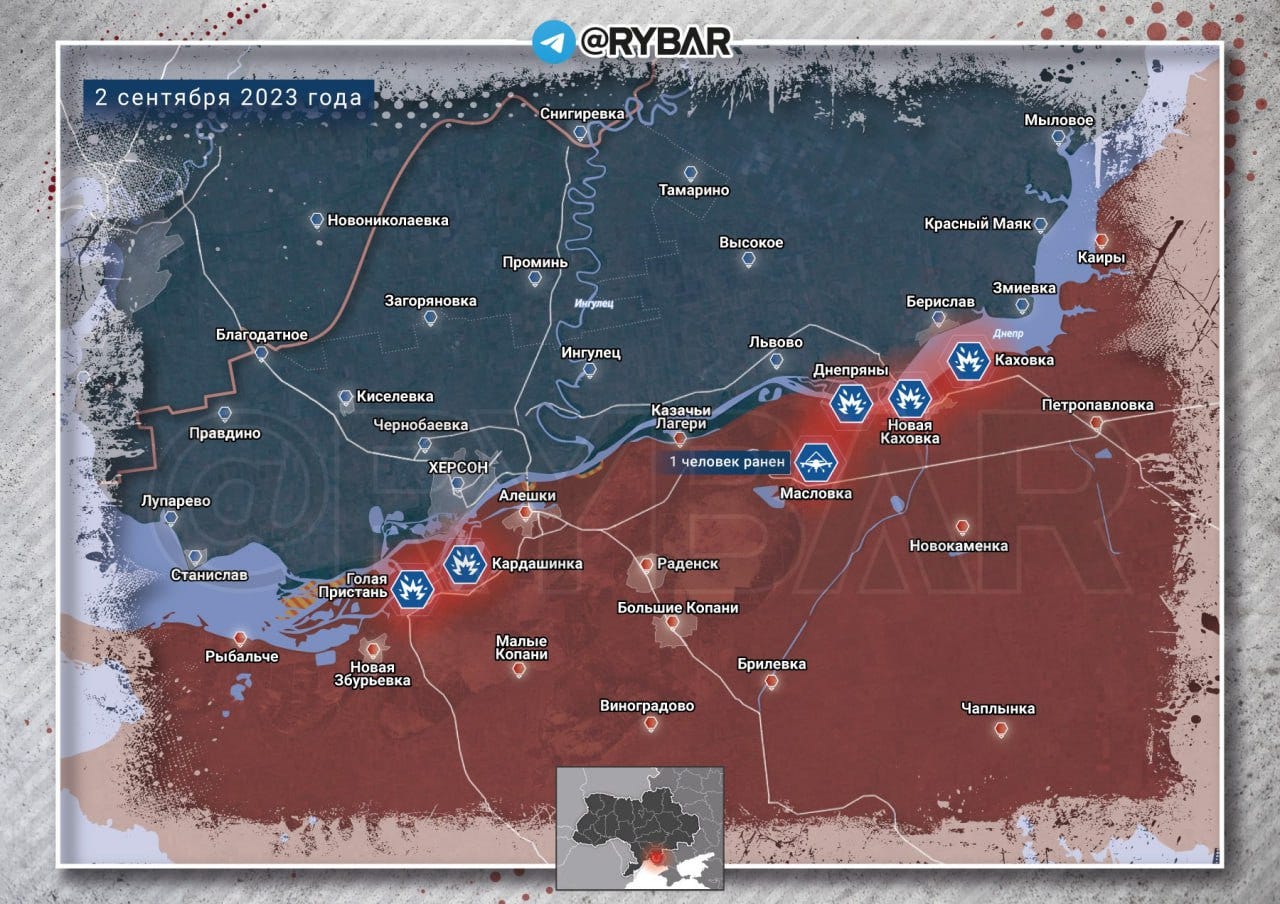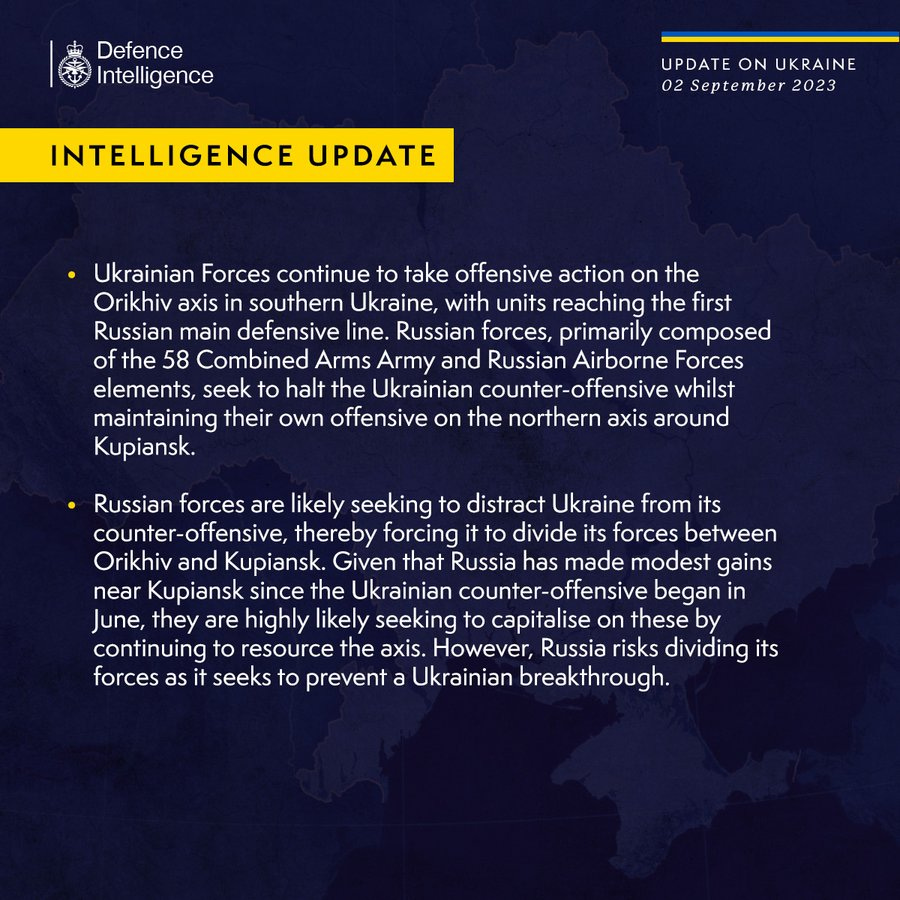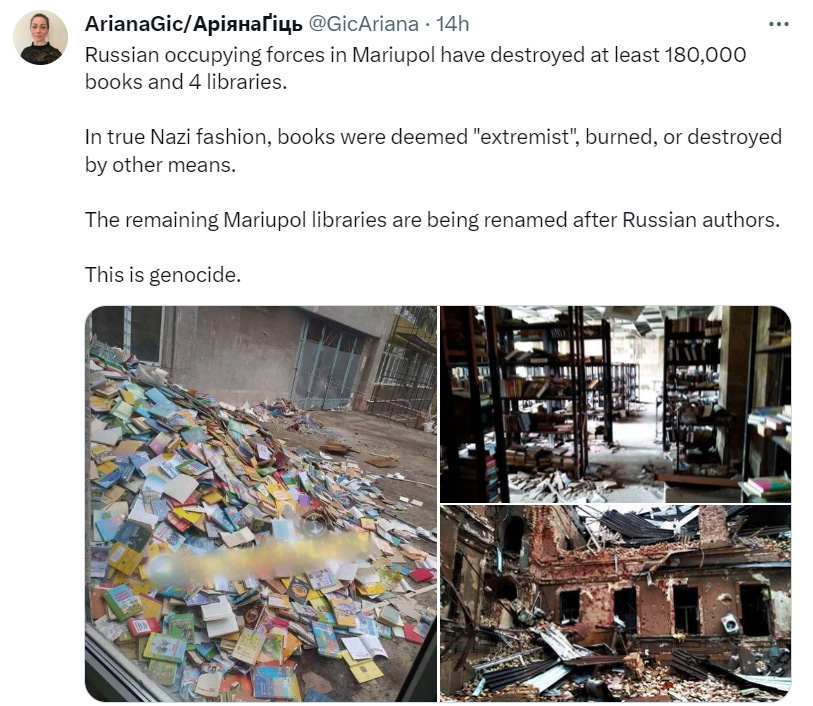Sept 3: Sunday Stories
Day 556: UAkids RUstrikes UASitRep Zapo RUSitRep Crimea Kirill -BehindLines OccupationElex Kolomoisky Rudy Iran Nobel France A&P UAArtHis ISW Ze UKDef Rybar SciuttoAfghanis Avdeeva Amanpour Gic
Catching up…
EA Worldview’s Ukraine Up-date- hop over to Scott’s amazing hourly Ukraine up-date page. I’ll fill in with some bits and bobs.
Stories we’re following…
Good news to start: The head of the president's Office, Andriy Yermak, reported that Ukraine had returned home a group of children from Russian captivity. According to him, 11 children were taken out of Russia during the last week. "We are working to find abducted children and return them home," he added.
Ukraine downs 22 drones in Odesa Oblast. Russia attacked Ukraine in several waves overnight on Sept. 3 using Iranian-made kamikaze drones, the Air Force said in its morning update. Russia used a total of 25 Shahed-136/131 drones against Ukraine's southern regions.
Governor: Russian guided bomb strike kills 1, injures 2 in the village of Odradokamianka in southern Kherson Oblast with guided bombs, killing one civilian and injuring two others, Governor Oleksandr Prukudin reported on Sept. 2.
Russian forces launched an attack on Vuhledar in Donetsk Oblast on Sept. 2, killing two and wounding another two, according to the Ukrainian authorities.
The Russians hit Kramatorsk with missiles in the evening on Sept 2. They destroyed the local cemetery. In addition, one unexploded shell got stuck on the road. No casualties were reported.
Russian artillery wounds 4 in Nikopol, Dnipropetrovsk Oblast ,and damaging houses and power lines, Dnipropetrovsk Oblast Governor Serhiy Lysak reported on Sept. 2.
Russian governors claim Ukraine attacked Belgorod, Kursk regions with multiple rocket launchers, mortars, and drones, killing 1 and injuring three residents on Sept. 2.
A large-scale fire broke out at a local refrigeration plant in St. Petersburg. Around 1400m² is on fire.
ISW: Russian officers reportedly contact former general, Major General Ivan Popov, amid deteriorating conditions on front line. Officers from the Russia's 58th Combined Arms Army (CAA) in western Zaporizhzhia Oblast have reportedly contacted their former commander, Major General Ivan Popov, ISW said in their latest update. This development comes as the situation on the Russian front line continues to deteriorate.
ISW: Ukrainian forces continue offensive operations near Bakhmut, advance in western Zaporizhzhia Oblast. The ISW reported on Sept. 2, citing Ukrainian General Staff, that country's forces continued offensive operations south of Bakhmut.
Obtained geolocated footage shows that Ukrainian forces marginally advanced northwest of Klishchiivka, some seven kilometers southwest of Bakhmut.
Locals report that in Tokmak, the sound of detonations were heard after an initial explosion. Initial reports indicate that it could be another ammunitions depot.
"Every time the enemy tries to reconnoiter what is happening on the left bank, they send their sabotage and reconnaissance groups on boats. Over the past day, they lost seven such boats. That is, every time an enemy group goes on a mission, it never returns," said Humenyuk.
Russia claims 3 unmanned boats destroyed trying to attack Crimea bridge. Russia's Defense Ministry reported in the early hours of Sept. 2 that its forces had destroyed three unmanned boats being used in an attempt to target the Crimea bridge. The ministry accused Ukraine of the attack.
“Ukraine has been working on its own missile programme and drones for a long time now, so hitting targets in Russian territory, even if they are located 1,500 km away, is no longer a problem," says Oleksii Danilov, Secretary of the National Security and Defence Council.
Russian air defence struggling with detecting, destroying OWA-UAVs – UK intel. Russian air defence is likely having difficulty detecting and destroying one-way attack uncrewed aerial vehicles (OWA-UAVs).
According to Japanese newspaper Mainichi Shimbun, the Russian military has moved S-300 air defense missile systems off the Kuril Islands. Citing Yu Koizumi from the University of Tokyo, who analyzed satellite images of the islands of Iturup and Kunashir, made by Maxar Technologies, Koizumi says new images do not show the air defense systems near Kasatka Bay on Iturup, or near Yuzhno-Kurilsk on Kunashir. Koizumi suggests that they may have been moved to the border with Ukraine for use in the war.
Maria Avdeeva: Guy next door, college mate, coworker, daughter of friends, son, father. This war came to every home. We remember and we have to win.
Christiane Amanpour: In Ukraine, ordinary civilian drones are proving indispensable in their war effort. This week, I visited a training facility at an undisclosed location to see first hand how this 21st century tech is transforming the battlefield -- often at the hands of some unlikely pilots.
Behind the Lines: Russia to introduce military training courses for students in occupied Crimea. Starting Sept. 1, Crimean students from grade five to nine will attend extracurricular activities called "Foundations of Military Training," Ukraine's Ombudsman Dmytro Lubinets reported on his Telegram. Lubinets said:
From today, Crimean schoolchildren from grades five to nine will attend extracurricular classes – ‘basics of military training’. And for students of the 10th and 11th grades, it was included in the OBZ program.
For this purpose, 25 Crimean teachers have already completed courses of military training, tactical medicine, to assemble and disassemble automatic weapons, organise life in a field camp, handle personal protective equipment and radiological, chemical and biological protection.
Behind the Lines: Elections are under way in Russian occupied territories of Ukraine as part of a move to cement Moscow’s authorities in its “new territories” despite the ongoing conflict. Russia does not fully control any of the four regions where the votes are being held – Donetsk, Luhansk, Zaporizhzhia and Kherson.
Interior Ministry: Russia-linked Ukrainian Orthodox Church priest charged with inciting religious hatred in Ukraine. The Interior Ministry did not mention the name of the priest but said he was a parson of the parish in the Ovrutsk-Korosten eparchy, located in central Zhytomyr Oblast. The priest faces a monetary penalty or up to five years in prison if found guilty.
Oligarch Kolomoisky charged with money laundering, fraud. Ihor Kolomoisky, one of Ukraine's most infamous oligarchs, was officially charged with fraud and money laundering. The Security Service said in its official statement that Kolomoisky is alleged of laundering over Hr 500 million ($13.5 million) in 2019-2020.
Monique: This is a huge deal.
Reuters: In the Baltic Sea, for the first time, exercises will be held to repel a Russian attack. Major naval drills about to start in the Baltic Sea involving some 30 ships and more than 3,000 Western service members will for the first time practice how to respond to a Russian assault in the region, Germany's navy chief said on Friday.
"We are sending a clear message of vigilance to Russia: Not on our watch," Vice-Admiral Jan Christian Kaack told reporters in Berlin. "Credible deterrence must include the ability to attack."
Iran’s news agencies reported that a Russian-made Yak-130 combat trainer aircraft is in the country and has joined the air force. The report by Isna said the advanced combat trainer aircraft is able to meet the training needs of pilots learning to fly fourth-generation fighters.
According to Bloomberg, India’s “splurge on cheap Russian crude” may be over, as Mid-East suppliers step back in with attractive conditions. “Our dependence on Russian oil is going to decrease sharply,” said Oil Minister Hardeep Puri.
A new Russian high school text book has sought to justify its war of aggression in Ukraine, as students returned to classes following the summer break.
The New York Times reports that a revised textbook alleges that Ukraine is an “ultranationalist state” where “opposition is forbidden,” and that the US is “the main beneficiary of the Ukrainian conflict.”
The rewritten version of “The History of Russia, 1945 to the beginning of the 21st Century,” a textbook for 16- and 17-year-old students, devotes almost 30 pages to the war. The NYT said the authors framed it as a response to “an increasingly aggressive West” that wanted to use Ukraine as a “battering ram” to destroy Russia.
Pjotr Sauer: The release of Russia’s first feature-length film about its invasion of Ukraine that premiered across the country on 17 August comes on the back of plans announced by the Russian authorities to boost the production of movies glorifying Moscow’s actions in Ukraine.
But The Witness is a box-office flop. Set to a budget of 200 million roubles (£1.5m), it has grossed less than 14 million roubles (£110,000) in its first two weeks, with viewers across the country reporting empty cinema halls.
In two hours of screen time, the film covers a wide spectrum of falsehoods that the Kremlin has used to justify its invasion of Ukraine. On the eve of the invasion, Vladimir Putin said Moscow had to “denazify” its neighbour, the lie that Ukraine was infiltrated by dangerous “Nazis”.
Nobel Foundation bars Russia, Belarus, Iran envoys from award ceremony in Sweden. The Nobel Foundation announced on Sept. 2 that it would not invite Russian, Belarusian, or Iranian ambassadors to Sweden to the Nobel Prize award ceremony in Stockholm.
“Thank you to everyone who demanded that justice be restored,” said Ukrainian foreign ministry spokesperson Oleg Nikolenko.
France has been assisting Ukraine in a fresh diplomatic effort to gather the support of more countries in the global south. The Financial Times reports there have been concerns that Russia emerged from the Brics summit in South Africa last week strengthened since it was announced that next year’s meeting would be held in Kazan, Russia. Dmytro Kuleba, Ukraine’s Foreign Minister, said:
This flexible method allows us to have a bigger coalition … Much work remains to be done and more diplomatic contacts will be needed. We will use the next session of the United Nations to organise more communication with countries in Africa, Asia and South America.
Jim Sciutto: my family in Afghanistan
Before reading: E-Stories is usually dedicated to Russia’s war of aggression in Ukraine, and European affairs, but this story is one of many that I have read since the NATO and US forces pulled out of Afghanistan. Claire Berlinski also tried to give support to people getting Afghan citizens out of the country. The lives of Afghanis who have served for NATO or American forces are in danger. It’s really that simple and I don’t know why the bureaucratic delay is still on-going. This thread was published on Twitter on August 31.
Two years ago today, the US announced the last C-17 carrying the last US forces had left Afghanistan. Today, many thousands of Afghans who served alongside the US and its allies remain behind. Listen to the harrowing & deeply frustrating story of just one family I know well.
I’m leaving out personal details for their safety but their story mirrors that of many others. I met them on a series of assignments in Afghanistan in the 2000s. They were full of hope the fall of the Taliban meant a new life, in school and at work and, for a time, it did.
One family member, the father, worked for US forces in a frontline role. The pay and the sense of mission was life-changing. They believed it was also a two-way commitment - him to the US and the US to him. The dangers were, after all, very real.
When the US announced its impending withdrawal, they became understandably nervous. Would the US-backed Afghan government survive? If not, would they have a way out? As US forces began the pullout and Taliban forces rapidly advanced, the answers became clearer to them.
They were among hundreds of Afghans swarming Abbey Gate at Kabul airport in the final days before the withdrawal. The father waved his ID and papers to US soldiers, hoping one would see he had worked for the US and let them in. An impossible task for the soldiers of course.
The mother was several months pregnant and too exhausted to stay in the crowd for too long. This might have saved their lives. They left only hours before the terrorist explosion that killed more than 100 Afghans and 13 US service-members.
Over the ensuing days and weeks, many Afghan vets escaped through the heroic work of US veterans like Scott Mann (@RooftopLeader) of “Pineapple Express”, who marshaled resources inside and outside the country to ferry them out. But the window for this route was short and most Afghan vets, including my family, didn’t manage to book a ride out. This began the long process of applying for a Special Immigrant Visa (SIV) made available to Afghans who served US forces in certain roles and for a certain amount of time. They met the standard.
Gathering documents to prove they met the standard is another thing. Even with my help from the outside, it took weeks. Then, after they submitted the completed SIV application to State, it took months to simply receive word they were SIV eligible - not approved - eligible.
It was 2022, nearly a year since the withdrawal. What now? Getting an interview at a US embassy. There’s no longer a US embassy in Afghanistan of course so they must arrange one outside the country, usually, Qatar or Pakistan. Another wait &,
eventually, costly travel abroad.We initially applied for them - with the help of an immigration lawyer in the US - in Qatar, which had proven a reliable path out. But the queue for SIV-eligible Afghans and their family members had by now grown well into the thousands. Flights out were managing, at best a few hundred a week. At that rate, they would be waiting *years* to leave the country for their interview. Throughout, the father was living mostly in hiding. The Taliban was looking for him and he knew from contacts that they were killing many Afghan vets they found.
We made the decision to move their interview to the US embassy in Islamabad, where they could travel overland rather than by plane and where the wait for an interview might prove shorter. This was another weeks-long wait in a process that was stretching into it second year.
This of course requires a Pakistani visa which is an expensive and lengthy process of its own. Today, two years after the last US military jet left, they are still waiting for both the Pakistani visa and their interview appointment at the US embassy in Islamabad.
The father remains in hiding, fearing for his life. And remember: theirs is one story of many thousands involving Afghan vets now facing similar long waits and deep uncertainty.












